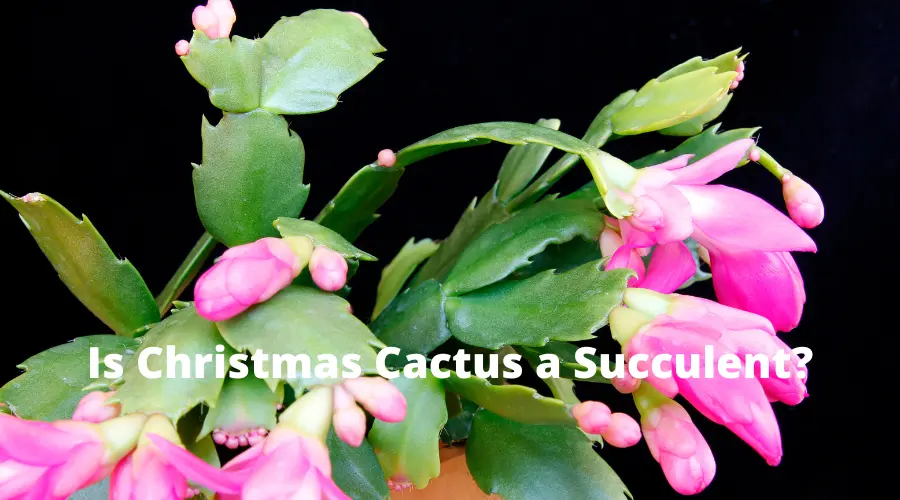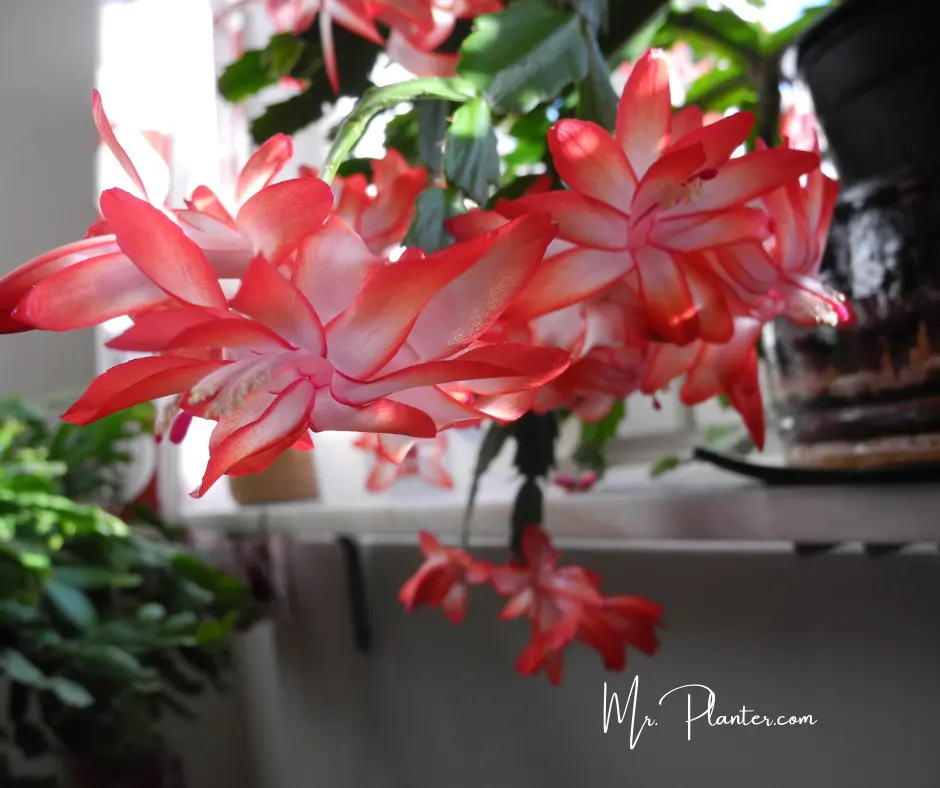If you’re a plant lover, you might be wondering whether your Christmas cactus is a succulent. Yes, the Christmas cactus, also known as Schlumbergera, is a type of epiphytic succulent that is native to the tropical forests of South America.
It is a popular houseplant that blooms during the holiday season, making it a festive addition to any home.
One of the most distinctive features of the Christmas cactus is its stem. Unlike other cacti, which have thick, spiny stems, the Christmas cactus has flat, segmented stems that are often mistaken for leaves.
These stems are actually modified leaves that store water, which is why the Christmas cactus is classified as a succulent. The leaves of the Christmas cactus are also succulent, helping the plant to retain moisture in dry conditions.

If you want to keep your Christmas cactus healthy and happy, there are a few things you should keep in mind. First, make sure to water it regularly, but be careful not to overwater it. Christmas cacti prefer well-draining soil and indirect light, so make sure to place it in a spot with bright, indirect light.
During the blooming season, which typically occurs in late fall to early winter, your Christmas cactus will need more water and fertilizer to support its growth. With the right care, your Christmas cactus can bloom for many years to come!
Is a Christmas Cactus a Succulent?
Yes, the Christmas Cactus is a Succulent. The Christmas cactus, also known as Schlumbergera, is a type of succulent plant that belongs to the cactus family. It is native to Brazil and other tropical regions of South America.
The Christmas cactus has a unique stem structure that sets it apart from other cacti. Unlike most cacti, the Christmas cactus does not have spines or thorns. Instead, it has flattened stems that resemble leaves. These stems are composed of segments that allow the plant to store water and nutrients, just like other succulents.
In addition to its stem structure, the Christmas cactus is also an epiphyte. This means that it grows on other plants, such as trees, in its native habitat. As an epiphyte, the Christmas cactus has adapted to absorb moisture and nutrients from the air and rain, rather than relying solely on its roots.
Speaking of roots, the Christmas cactus has shallow roots that spread out wide. This allows the plant to absorb moisture quickly and efficiently, which is important for its survival in its native tropical environment.
Overall, the Christmas cactus is a unique and fascinating plant that combines the characteristics of both cacti and succulents. Its flattened stem structure, epiphytic growth habit, and shallow roots make it a tropical succulent that is easy to care for and a popular choice for indoor houseplants.
What is a Christmas Cactus?
Christmas cactus is an epiphyte, which means it grows on other plants, but it’s not parasitic. It’s native to the rainforests of Brazil, where it grows on trees and rocks. The stem of the Christmas cactus is flat and segmented, and it has small, spineless leaves that grow along the edges of the segments.
The roots of the Christmas cactus are also different from those of a typical cactus. They are thin and fibrous, and they grow close to the surface of the soil. This makes them more efficient at absorbing water and nutrients from the soil.

Unlike most cacti, the Christmas cactus doesn’t thrive in hot, dry conditions. Instead, it prefers cooler temperatures and higher humidity levels.
It’s a popular houseplant because it’s easy to care for, and it produces beautiful flowers in shades of pink, red, and white during the winter months.
Christmas cactus is often confused with other plants, such as the Thanksgiving cactus or the Easter cactus, which belong to the Hatiora genus. While these plants are similar in appearance and care requirements, they have different blooming times and slightly different foliage.
Care Tips for Christmas Cactus
Taking care of your Christmas cactus is easy, and it will reward you with beautiful blooms every year. Here are some care tips to help you keep your plant healthy and happy.
Light Requirements
Christmas cactus prefers bright, indirect light. It can tolerate some direct sunlight, but too much can burn the leaves.
If your plant is not blooming, try moving it to a brighter spot. On the other hand, if the leaves are turning yellow, they may be getting too much light.
Watering
Christmas cactus needs regular water, but it doesn’t like to sit in wet soil. Water your plant when the top inch of soil feels dry.
Make sure the pot has drainage holes to prevent water from accumulating in the bottom. During the blooming period, keep the soil slightly moist but not soggy.
Soil and Fertilizer
Christmas cactus prefers well-draining soil that is rich in organic matter. Use a potting mix that is specifically formulated for cacti and succulents.
Fertilize your plant every two weeks during the growing season with a balanced fertilizer. Do not fertilize during the blooming period.
Temperature and Humidity
Christmas cactus does best in temperatures between 60-70°F (15-21°C). It can tolerate cooler temperatures but not freezing. High humidity is beneficial, but avoid placing your plant near drafts or heaters that can dry out the air.
Repotting
Christmas cactus likes to be slightly root-bound, so you don’t need to repot it often. Repotting every 2-3 years is sufficient. Use a pot that is only slightly larger than the current one and fill it with fresh potting soil. Repot in the spring when the plant is coming out of dormancy.
Remember that Christmas cactus is toxic to dogs and cats, so keep it out of reach of pets. With these care tips, your Christmas cactus will thrive and bloom for many years to come.
Blooming and Dormancy
If you want your Christmas cactus to bloom, you need to provide it with the right conditions. Christmas cacti, also known as Schlumbergera, are native to the rainforests of Brazil, where they grow as epiphytes on trees. These plants typically bloom in late fall or early winter, around the time of the holiday season.
To encourage your Christmas cactus to bloom, you need to provide it with the right amount of light, darkness, and water. During the growing season, which runs from spring to early fall, you should water your cactus regularly and keep it in a bright location with indirect sunlight. This will help it grow healthy stems and leaves.
As the days get shorter in the fall, you should reduce the amount of light your Christmas cactus receives each day. This will help trigger the plant’s natural blooming cycle. To do this, you can move your cactus to a darker location or cover it with a cloth for about 12-14 hours each day. You should also reduce the amount of water you give your cactus during this time.
Once your Christmas cactus has entered its blooming cycle, you can expect to see flower buds develop on the tips of its stems. The bloom time for Christmas cacti can vary depending on the hybrid, but it typically lasts for several weeks. The flower color can range from pink to red to white, depending on the variety.
After your Christmas cactus has finished blooming, it will enter a period of dormancy. During this time, you should reduce the amount of water you give your plant and move it to a cooler location with indirect sunlight. This will help it rest and prepare for the next growing season.
Common Problems and Solutions
If you’re having issues with your Christmas cactus, don’t worry. Many common problems can be easily solved with a little bit of care and attention. Here are some of the most common problems and their solutions:
Diseases and Pests
Like any plant, Christmas cacti can be susceptible to diseases and pests. Here are some of the most common issues and how to deal with them:
- Root rot: This can occur if the plant is overwatered or if the soil doesn’t drain well. To prevent root rot, make sure your plant is in well-draining soil and only water it when the top inch of soil is dry.
- Mealybugs: These small, white insects can infest your plant and cause damage. To get rid of them, you can use a cotton swab dipped in rubbing alcohol to wipe them off the leaves.
- Scale: These pests look like small, brown bumps on the leaves and stems of your plant. To remove them, you can use a cotton swab dipped in rubbing alcohol to wipe them off.
Overwatering and Underwatering
One of the most common problems with Christmas cacti is overwatering or underwatering. Here’s how to tell if your plant is getting too much or too little water:
- Overwatering: If the leaves are turning yellow or brown and are mushy to the touch, you may be overwatering your plant. To fix this, reduce the amount of water you’re giving it and make sure the soil is well-draining.
- Underwatering: If the leaves are wrinkled and dry, your plant may not be getting enough water. To fix this, water your plant more frequently and make sure the soil is moist but not waterlogged.
Toxicity to Pets
If you have pets, it’s important to know that Christmas cacti can be toxic to dogs and cats. Here’s what you need to know:
- Toxicity: The leaves of the Christmas cactus contain a sap that can be irritating to pets if ingested. Symptoms of toxicity include vomiting, diarrhea, and lethargy.
- Prevention: To prevent your pets from getting sick, keep your Christmas cactus out of reach or consider choosing a different plant that is not toxic to pets. In case your pet ate it, consult a veterinary doctor immediately.
By following these tips and tricks, you can keep your Christmas cactus healthy and thriving. If you’re still having issues, consider consulting with experts such as commercial growers or gardeners for more personalized care advice.
Remember to repot your plant every few years and to keep an eye out for any signs of distress, such as wilting leaves or yellowing stems. With a little bit of care and attention, your Christmas cactus can be a beautiful addition to your home.

